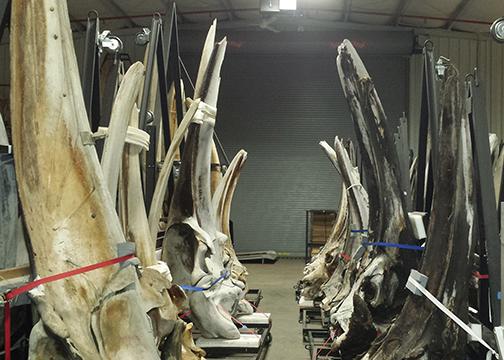A new study conducted by a San Diego State biologist revealed that baleen whales are able to hear through their skull.
SDSU biologist Ted Cranford and University of California, San Diego structural engineer Petr Krysl showed through research that whales are able to detect low frequency sounds through the vibration of their skull.
It was previously thought that the whales would hear through a pressure mechanism, meaning sound would go through the water and through the head to then push on the ear, similar to how toothed whales hear.
But Cranford and Krysl found that these whales have two mechanisms for hearing, both the pressure mechanism as well as through bone conduction, which is the process of low frequency sounds causing the skull of the whale to bend, making the ears wiggle.
Cranford said through bone conduction the whales are between 4 to 10 times more sensitive to sounds, depending on the frequency.
“That wiggling of the ears is primarily how they hear low frequency sounds,” Cranford said. “They are a lot more sensitive to the sounds that they hear by bone conduction than by pressure mechanism.”
These low frequency sounds allow for whales to communicate at a much farther distance, but man-made noise is making it increasingly difficult for these whales to communicate.
Energy exploration, military exercises, wind farms and commercial shipping all contribute to the man-made noise in the ocean.
“Since commercial shipping noises and the whale noises are in about the same frequency range, it might be difficult for the whales to hear each other over longer distances like they could 50 years ago because now there is a lot more noise,” Cranford said.
Because of this man-made noise, scientists and advocates have been trying to implement a policy restricting the amount of human noise through the Marine Mammal Protection Act. The act was put into place in 1972, creating policies to protect endangered marine mammals.
“The government was trying to come up with some regulations and limitations to how much sound these animals could legitimately be exposed to,” Cranford said. “The problem with making those sort of regulations is that we didn’t know how whales hear or how sensitive they are.”
In order to put limits on the amount of man-made low frequency noise in the ocean, scientists needed to figure out how the whales hear and how sensitive they are to the noises.
The scientists have not yet pinpointed whether the whales may be having a difficult time hearing another whale due to the presence of ocean noise or whether it may be because of the “directional characteristics of the whales’ hearing systems.”
Cranford said they don’t know too much about the directional characteristics of the hearing systems just yet, but the next step in understanding whale communication and hearing is to figure out whether the direction of the sound makes any difference.
Using a scanner for rocket motors at the Hill Air Force Base, Cranford was able to scan a whole baleen whale, a minke whale.
The whale was provided by the Smithsonian Institution Natural Museum of Natural History and took five days to scan.
“For the first time we now have a scan of a whole whale,” Cranford said. “We now want to use that scan to answer the question of how sensitive a whale might be to a sound that comes from behind them.”







